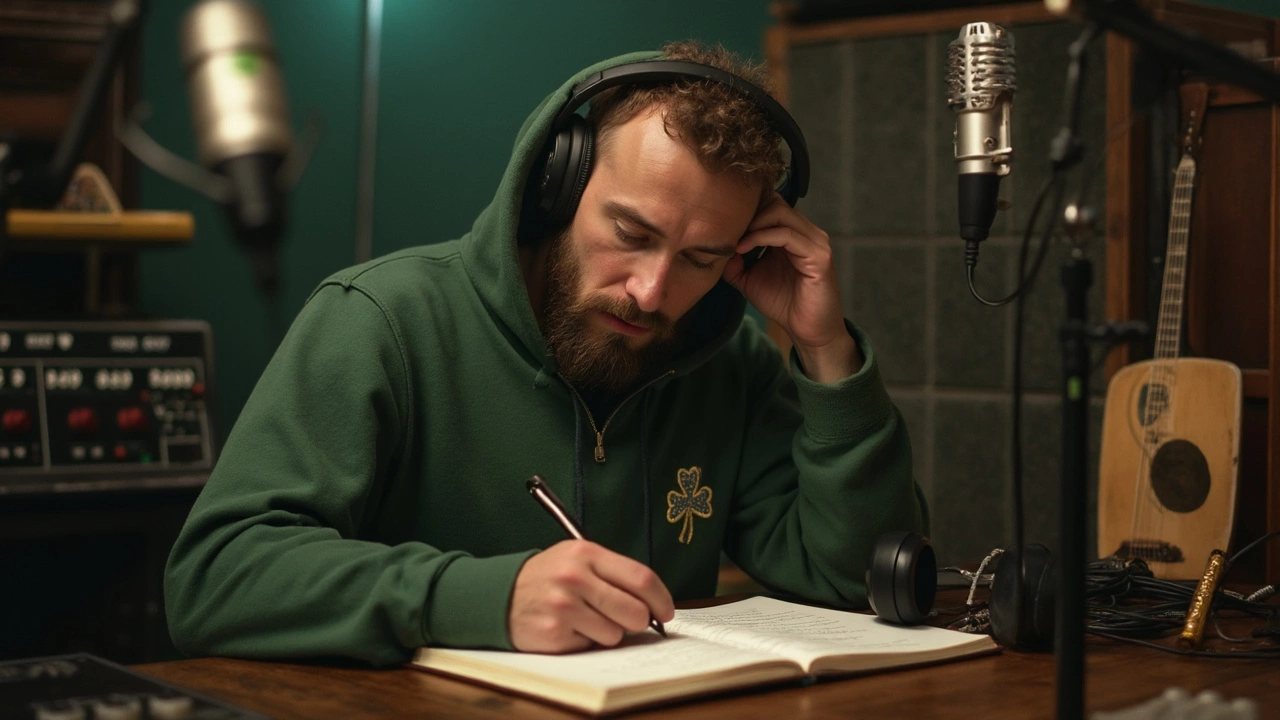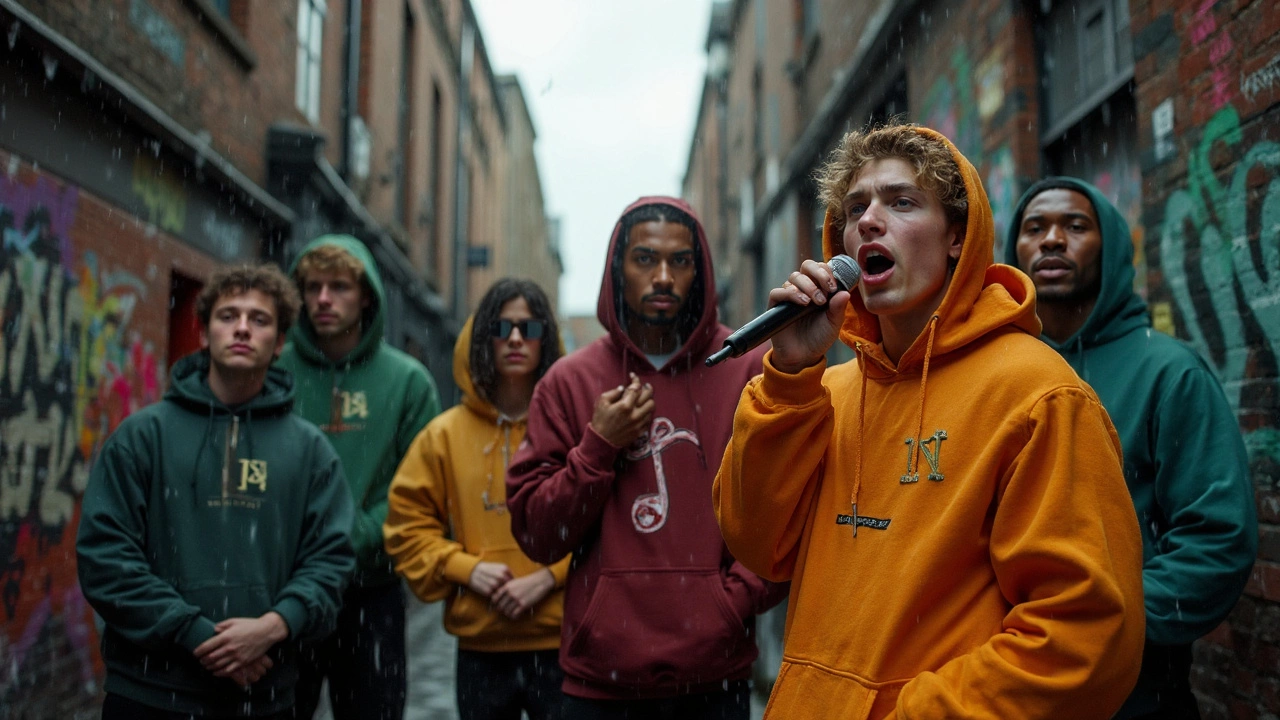You can spot them on stage during Longitude at Marlay Park, rapping with raw energy in Temple Bar, or filming late-night videos on Grafton Street—rappers in Ireland practically have a uniform, and the hoodie is its centrepiece. This isn’t just about the international scene. Here, in the rain, wind, and streets of Cork, Galway, and Dublin, this simple piece of clothing says a lot more than you’d think. Ireland’s urban music scene has exploded recently, moving well beyond imported American sound. Irish rappers have unique reasons for what they wear, and for every oversized hoodie that pops up, there’s a story behind it.
The Hoodie: Comfort, Identity, and Protection in Irish Hip-Hop
Hoodies aren’t just about looking cool—though, let’s be honest, they do that too. In Ireland, with our famously unpredictable weather, it’s literally practical. Ask any Dublin rapper dodging rainclouds on Northside or a crew filming in the biting wind by the River Lee, and they’ll rate warmth and dryness high on their list. But it’s more than shelter. Rappers use hoodies as an extension of their identity. They can help someone blend in with the crowd, or stand out on stage—the anonymity to work on verses on the LUAS without glare, and the confidence to face down a crowd at a packed Cork open mic. Irish MCs have talked about feeling shielded against the world while sharing their stories—childhood, heartbreak, growing up on council estates, or hustling to stand out in a tiny market.
It doesn’t stop at comfort. Hoodies are a badge of loyalty to hip-hop culture. Bet you’ll spot artists repping local crews with a bespoke embroidered hoodie at a sold-out gig in The Academy, just as often as you’ll see someone throw up their hood at the skatepark in Limerick. It’s a shout-out to American rap roots, but also a nod to the new wave of Irish beats. RTE Radio 2FM’s chart-topping Irish rappers—like Jafaris or Rejjie Snow—often favour classic hoodies paired with tracksuit bottoms. When they pop up on the Late Late Show or play a gig for Irish Youth Music Awards, it’s clear the look is more than surface-deep. It’s about staking out space in a world where hip-hop was once mostly seen as a Stateside thing.
This isn’t unique to Ireland, of course, but the local twist is hard to miss. You’ll spot familiar logo hoodies—think O’Neills, Fila Ireland, Carhartt WIP, and even niche Irish streetwear like Human Collective. Local acts drop collabs with these brands, adding Gaeilge slogans and bold Irish prints. For some, it’s about reclaiming the image—giving it home-grown pride. It’s hard to separate the hoodie from Irish youth identity now, and let’s be fair, with the rising cost of living, students and new artists lean on style that won’t break the bank yet still looks sharp under club lights or for a spontaneous session in Stephen’s Green.
History: The Hoodie’s Roots, Pop Culture Influence, and Controversy in Ireland
If you trace the hoodie’s roots, you’ll find it dates back decades. It began as workwear for New York labourers during the 1930s, then became a symbol of rebellion worldwide via American hip-hop in the 1980s. By the early 2000s, Irish media was locked in a moral panic over ‘hoodies’—as if the garment itself guaranteed trouble. Remember when some shopping centres around Dublin and Dundalk actually banned hoodies, convinced that anyone in one was up to no good? Irish tabloids ran stories about ASBOs and anti-social teens in tracksuits squaring up on Moore Street.
That stigma didn’t last in the face of real-life creativity. People here flipped the script, especially the first big Irish rap acts who saw the hoodie as a tool for artistic protest, not crime. If you watched the rise of Rsag or Lethal Dialect in the early 2010s, you’d see a bunch of MCs turning the hoodie into a piece of stagecraft, swagger, and local flavour. Irish youth started to wear their hoods proud—public transport, street cyphers, or college lectures at Trinity—less because of ‘intimidation’ and more because it felt empowering. Cultural acceptance has grown, but the old prejudices sometimes resurface in small towns and villages, especially among older generations. Yet, every Kirwan Street block party, every hip-hop workshop in Galway, and every selfie snapped in a custom hoodie at Body & Soul festival adds a bit to shifting perceptions.
Pop culture didn’t just reflect change—it drove it. RTÉ’s “Love/Hate” drama made the hoodie look almost iconic in the Irish underworld, blending real anxiety with style. After the show, you saw a jump in sales at Penneys and Urban Outfitters, as people wanted the gritty street credibility with a playfully Irish edge. GQ Style UK once ran a feature calling the Dublin hoodie ‘a surprisingly versatile layer for unpredictable summer nights.’ Brands responded. You’ll see Irish startups making eco-friendly hoodies, and collectives running limited-edition drops featuring artwork from Cork graffiti artists or Galway muralists.

Fashion Statements: From DIY to Designer, Irish Hip-Hop’s Changing Look
While hoodies started out plain and practical, the Irish hip-hop scene quickly made them a canvas for creativity. Walk down Henry Street or check the queues outside Tower Records after a hip-hop album launch, and you’ll notice the range. Some wearers go for classic dark colours—navy, grey, black—keeping it low-key. But plenty flash bold patterns, oversized fits, or vintage retro patches showing off crews and causes. The rise of Irish streetwear labels like Human Collective or Ethical Silk Company has given rappers a chance to support home-grown talent while looking sharp.
There’s even a second-hand culture around the hoodie. With the rise of Depop Ireland, thrift shops in places like Galway’s Westend, and Cork’s Mother Jones market, you’ll find vintage Nike, Adidas, and Tommy Hilfiger hoodies next to limited-run pieces from Irish bands. The cultural message? If you want to support local, don’t just focus on what’s new or mass-produced—hunt for one-off finds with a bit of character. For a rapper on a tight budget, that’s practical. For the eco-minded, it means sustainability and anti-fast fashion.
Irish events—think All City Jam, Make a Move in Limerick or the Hot Press Y&E Series—are perfect runways to show it off. It's not uncommon to see a rapper clad in an oversized hoodie with bold Celtic graffiti or even an in-joke only regulars on the Irish hip-hop subreddit would catch.
| Popular Hoodie Brands among Irish Rappers | Popular in |
|---|---|
| O’Neills | Dublin, Cork |
| Carhartt WIP | Galway, Limerick |
| Fila Ireland | Dublin (N7, Blanchardstown) |
| Human Collective | National |
| Penneys (Primark) | Everywhere |
Even the way hoodies are styled sends a message: hood up for privacy or for intensity on stage, zipped down for banter in the smoking area, sleeves pulled tight on a miserable Irish evening. These small details tell you whether someone is repping their scene, hiding from the rain, or just wants another layer before a gig at Workman’s Club. The best part? This look isn’t reserved for the lads. Plenty of talented female MCs—like Celaviedmai, Gemma Dunleavy, and Erica Cody—have put their own spin on the classic hoodie, showing it's genderless and open to everyone.
Why It Works: Social Statements, Community, and Irish Street Vibes
A hoodie isn’t just about fashion, comfort, or imitating American rappers. In the Irish context, it’s often a way to claim space. There’s something powerful in the way a group of young artists in matching hoodies takes over a street stage at Culture Night, inviting the public to watch, join, or rap along. In a country where the arts can be underfunded—where even busking on Grafton Street comes with waitlists and strict rules—the hoodie’s DIY, grassroots vibe fits right in. It's practical in a literal Irish drizzle, especially for artists who might be carrying gear to open mic nights in Rathmines or performing at pop-up events at EPIC The Irish Emigration Museum.
But there’s more underneath. The hoodie can be a subtle social protest. When housing and social inequality make headlines in Irish Times, rappers use the hoodie to express solidarity and resilience. You’ll see charity runs—like Pieta House’s Darkness Into Light—where Irish rap collectives hand out limited-edition hoodies as fundraising merch. Community youth projects—BASE Ballyfermot, Foróige clubs, and the Lord Mayor’s Youth Awards—often give out branded hoodies to empower teens and keep them connected. For minority communities in Ireland, a hoodie is something familiar—it’s low-cost, versatile, and helps you feel included when settling in from Poland, Nigeria, Brazil, or Syria.
This shared look connects new Irish talents with older generations and wider communities. Irish mammies might have once asked if you were “up to no good” when heading out in a trackie and hoodie, but more often now, especially after films like 'Dublin Oldschool,' there’s understanding that it’s just part of expression. With the recent embrace of drill, grime, and conscious rap, hoodies are as likely to be worn by poets and spoken-word artists as by beatboxers and DJs. That cross-pollination brings together fashion and music in a uniquely Irish way, right down to the Guinness-branded hoodies you’ll see at sports pubs on match days or during All-Ireland Finals.
Next time you spot a crowd in hoodies south of the Liffey or rapping in a campus bar, think about what those layers mean. They’re not just a nod to American hip-hop—they’re a blend of Irish practicality, protest, pride, and creative reinvention. They’re how a new wave of voices finds comfort in community and turns a simple piece of fabric into something a bit magical, in that only-in-Ireland sort of way.
